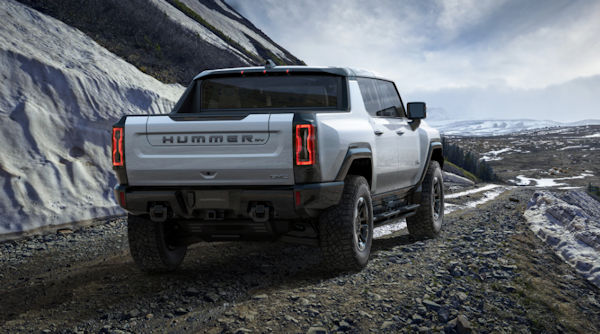SEJournal Online is the digital news magazine of the Society of Environmental Journalists. Learn more about SEJournal Online, including submission, subscription and advertising information.
 |
| General Motors appears to be hedging its bets on the auto industry’s future with a new electric Hummer, pictured above. But while the upcoming production run sold out in minutes, critics cited the need for far more affordable electric vehicles. Photo: GM. Click to enlarge. |
Issue Backgrounder: Carmakers Map Out Shifting Road Ahead
EDITOR'S NOTE: This story is one in a series of special reports from SEJournal that looks ahead to key issues in the coming year. Visit the full “2021 Journalists’ Guide to Energy & Environment” special report for more.
 |
By Joseph A. Davis
Cars and trucks define a crucial battlespace in the fight for the planet’s future. It has been so for half a century. Now it’s more so. The auto industry is at a crossroads.
The choice is between doubling down and persisting in climate-changing carbon dioxide emissions — or shifting toward more climate-friendly paths like electric or hydrogen. Between continued job loss and building new industries in the United States that add jobs. Between cars themselves and other forms of transportation like mass transit and bicycles.
But now that Democrat Joe Biden has won the presidency, the bumpy road ahead for the auto industry may be a bit less foggy.
First, let’s back up a bit [sounds of beeping].
Currently, greenhouse gas emissions from transportation in the United States surpass those from generating electricity. And scientists are warning us that we have at most 10 years to get carbon emissions under control if we hope to save planet Earth from the worst of runaway, devastating warming.
But with the future of global climate at stake, we are in the final, indecisive spasms of a regulatory war over auto emissions that has split the country and the industry.
And we still love trucks. Although, really, it’s all about the electric Hummer (more on that in 0-60 time).
California as clean air pioneer
The Trump administration’s oft-declared war on California has recently included a separate battle over California’s special waiver to set standards stricter than the Clean Air Act.
More backing up. More beeping.
In 1943 the smog in Los Angeles, a city dedicated to cars and freeways, was so bad that people thought the Japanese had launched a chemical attack.
Smog combined fog with ground-level ozone, while several ingredients in car emissions, cooked in sun and humidity, and contained in the basin of L.A.’s topography, made that smog especially potent. It caused people’s eyes to burn and noses to sting. Not only did it aggravate asthma, it damaged lungs.
Economic and freeway growth in the post-war 1950s made it worse. Because it had to, California struggled alone with its air pollution problem. It invented government efforts to deal with it — such as the California Air Resources Board, or CARB, and the South Coast Air Quality Management District.
It was only a few years later, when cities across the country were tired of suffering with similar problems, that Congress passed the landmark Clean Air Act of 1970, the first federal air pollution law with teeth. The act prohibited states from setting standards stricter than federal ones unless they got a waiver — a provision written with California squarely in mind.
Since California is an important market for
carmakers, by setting tougher standards, it
challenged carmakers to meet them. Some did.
By 2009 California had started setting standards for auto greenhouse gas emissions. Since California is a huge state with endless freeways, it’s also an important market for all carmakers. By setting tougher standards, it challenged carmakers to meet them. Some did.
So California was raising the bar for all carmakers, whatever the national standards. Some 13 states adopted California’s standards.
Obama initiatives rolled back by Trump
Fast-forward to the Obama administration.
Carmakers and regulators had been arm-wrestling (may require subscription) over auto mileage standards for decades. The surprise came in July 2011 when most of the major carmakers made a deal with federal regulators on a timetable to reach a very ambitious 54.5 mpg by 2025 on cars and light trucks.
The difference was that it was part of President Barack Obama’s climate program, which had to rely on executive action in the face of Congressional stalemate. It was aimed at carbon dioxide, rather than the other tailpipe pollutants.
Also noteworthy was the seeming agreement of most carmakers. They had bargained Obama and the environmentalists down from even more ambitious targets and may have accepted the (still ambitious) deal because it gave them the “regulatory certainty” they so often claimed to seek.
That, and the fact that Obama had rescued (may require subscription) some U.S. auto companies from financial ruin in the great recession at the beginning of his administration.
Then came Donald Trump.
It would be only a slight exaggeration that the Trump administration was determined to roll back almost all agency action that had the name Obama attached to it. Inevitably, rolling back the new auto emission standards, a joint product of Obama’s Environmental Protection Agency and National Highway Traffic Safety Administration, was a must for Trump, whether or not it made sense.
Although preparations for the new mileage
standards were already underway, Trump
formally proposed rolling back the changes
in 2018 and finalized the rollback in 2020.
So although preparations for the new mileage standards were already underway, Trump formally proposed rolling back the changes in August 2018. He then finalized (may require subscription) the rollback in March 2020.
Not coincidentally, going after the Obama emissions standards was also a chance to stick it to California, which had been part of the Obama standards deal (revenge on blue states had been a Trump pattern). The Trump administration had made clear by September 2019 that it intended to repeal (may require subscription) California’s 50-year-old Clean Air Act waiver as part of its auto rollback.
That wasn’t the end of the story. Trump’s rollback attempt split both the states and the carmakers. By May 2020, 23 states (may require subscription) had gone to court challenging the Trump rollback. And California’s attorney general was not just suing over his state’s waiver; he was leading the coalition.
Some might say the sweetest payback was California’s CARB’s success in carving off a big chunk of the auto industry to support its own more stringent standards. Initially, the coalition included Ford, Volkswagen, Honda and BMW.
Electric Hummer on the road ahead?
And there it stood as Americans voted in November 2020. A nation divided. An industry divided. A six-lane interstate highway of lawsuits farther than the eye could see. An oil industry tanking, having pumped dry the gusher of favors offered by the Trump administration.
Then — even before the election — came General Motors’ electric Hummer. GM, one of the companies that had thrown in their lot with the Trump administration, apparently wanted to hedge its bets.
You can get the Hummer EV with 1,000 horsepower and 11,500 foot-pounds of torque, clocking 0-60 in three seconds, and promising next-level “off-road dominance” (along with features we just don’t want to talk about, like Crabwalk and Ultravision).
Although the vehicle was priced well upward from $79,995, the first year’s (2022) production run, which hadn’t even happened yet, sold out in 10 minutes.
Perhaps not surprisingly, the Hummer EV did not delight many environmentalists and liberals. One journalist called it “the perfect analog for late-stage capitalism,” and made the point that what the country needed was an electric vehicle that people could afford.
But it was also a sign that the terrain had shifted (whatever vehicle happened to be navigating it).
Even before the election, Biden had called an audible in the second presidential debate, saying he wanted to “transition” (may require subscription) the nation away from oil. Later explainers said it was not a gaffe (may require subscription) but a policy statement. One, they added, that would not hurt him in the polls.
Soon thereafter, but still before the election, people started writing about the phasing out of combustion-engine cars (not as though it were an un-American Communist plot). And saying it was part of Biden’s climate plan. Which it more or less was, although it was merely implied by his support for a zero-emission vehicle standard, something that California had set years before. Although at least one reporter noted that Biden had mentioned no timetable for achieving any phase-out.
GM U-turn on tougher standards
Even with Democratic control of the White House and House (and perhaps the Senate), the path to zero-carbon cars will be fraught with political and legal obstacles. But it may mean the hammering out of new deals of whatever degree of greenness. Politically, it will be a long haul and a heavy load.
One sign of the times, however: speculative articles about short-list possibilities for administrator of EPA. Among the most-often mentioned names is that of Mary Nichols (may require subscription), chair of California’s CARB and engineer of the coalition of carmakers who opposed Trump’s rollback of auto standards earlier in 2020. [Biden had not chosen an EPA head as of this writing].
GM announced that it was switching sides in Trump’s
legal war on California, joining the companies that
would try to meet California’s tougher standards.
Yet another sign of the times: a policy U-turn by GM. Barely two weeks after the election, GM announced that it was switching sides in Trump’s legal war on California, joining the companies that would try to meet California’s tougher standards.
This was not simply opportunism. GM had started changing course (may require subscription) even before the election.
Beyond the e-Hummer, GM envisioned rolling out another electric truck, similar to a Silverado, and trying to win technological leadership in battery technology. The company is now investing billions in electric vehicles, and declaring itself to be on the path to an all-electric future. And they were not the only carmakers on this road.
In America, even the auto plants themselves are also symbolic. Earlier in 2020, the plant that GM had closed in 2019 in Lordstown, Ohio, was reopening under another company to make electric pickup trucks. And GM was building a new battery plant there.
Of course, electric vehicles need customers who want to buy them. Because you don’t really want to drive a car, do you? You want to drive a symbol.
Still, as the Biden administration takes over, it appears that climate-control measures for vehicles might have an easier ride than expected.
Joseph A. Davis is a freelance writer/editor in Washington, D.C. who has been writing about the environment since 1976. He writes SEJournal Online's TipSheet, Reporter's Toolbox and Issue Backgrounder, as well as compiling SEJ's weekday news headlines service EJToday. Davis also directs SEJ's Freedom of Information Project and writes the WatchDog opinion column and WatchDog Alert.
* From the weekly news magazine SEJournal Online, Vol. 5, No. 44. Content from each new issue of SEJournal Online is available to the public via the SEJournal Online main page. Subscribe to the e-newsletter here. And see past issues of the SEJournal archived here.












 Advertisement
Advertisement 



